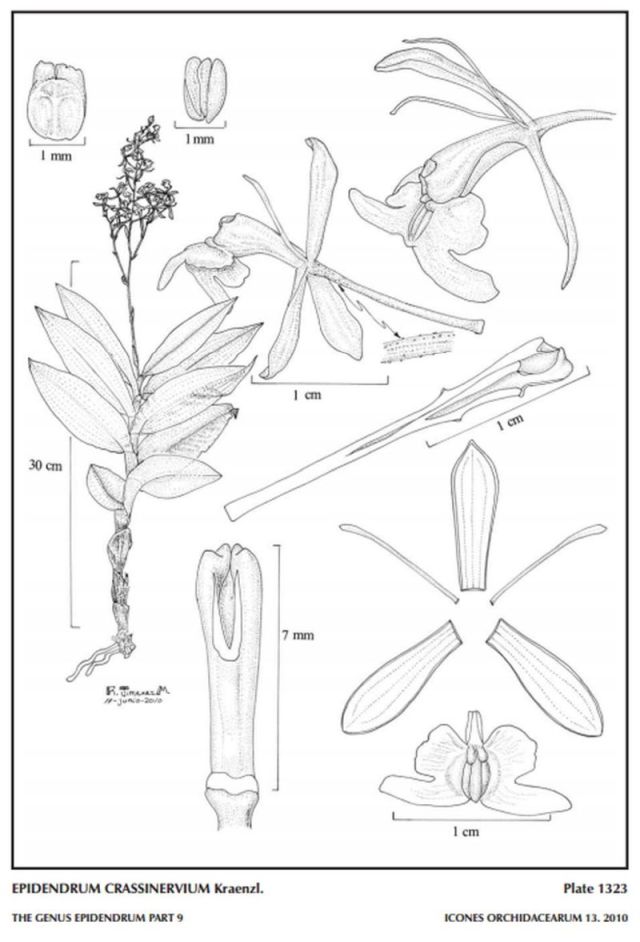

Epidendrum crassinervium Kraenzl. 1905 GROUP Pseudepidenrum SUBGROUP Paniculatum
TYPE Drawing by © Jimenez and The AMO Herbaria Website


 MID
MID  MID
MID 
Common Name The Thick Nerved Epidendrum [refers to the 7 thickened veins of the sepals when dry]
Flower Size .8" [2 cm]
Found in southern Bolivia and northern Argentina at elevations of 600 to 1100 meter as a medium sized, warm to cool growing epiphyte with cane-like, laterally compressed stems carrying 9 to 10, all along the stem, articulate, distichous, unequal in size and shape, basal leaves smaller, oblong-lanceolate, short acuminate, margin entire leaves that blooms in the mid winter through mid fall on a terminal, paniculate, suberect, occuring only once, peduncle laterally compressed, provided with 2, conduplicate, tubular, ancipitous, acuminate, amplexicaul bracts, subdense, simultaneously to 70 flowered inflorescence with much shorter than the ovary, narrowly triangular, acuminate, amplexicaul floral bracts and carrying resupinate, white, turning yellow flowers.
"Epidendrum crassinervium belongs to the GROUP Pseudepidenrum and is characterized by caespitose plants, cane-like stems, acute to acuminate leaves, apical inflorescence, lacking a spathaceous bract, the petals filiform and the lip usually 3-lobed, with 3 parallel fleshy keels, the apical lobe often bifurcate, and the pollinia “bird-wing” type and SUBGROUP Paniculatum which has green and white flowers, often marked with purple on the disc of the lip and apex of the column. The species is recognized by the sub-erect racemes of the paniculate inflorescence with respect to the rachis, the white, glabrous flowers turning yellowish with age, ovary scarcely short-pilose, and the mid-lobe of the lip strongly divaricate, wider than between the lateral lobes. Epidendrum paniculatum has the racemes of the paniculate inflorescence spreading with respect to the rachis, green flowers with a white lip, and an unornamented ovary. Epidendrum humidicolum Schltr. has the base of the lip truncate, is only slightly wider between the apical lobes than between lateral lobes, and the margin of the lateral lobes is irregular, the ovary unornamented." Hagsater etal 2010
Synonyms
References W3 Tropicos, Kew Monocot list , IPNI ; Repert. Spec. Nov. Regni Veg. Beih. 10: 70 Schlechter 1922; Orchids of Bolivia Vol II Laelinae Vasquez & Ibisch 2004 photo good; Icones Orchidacearum 13 Plate 1323 Hágsater & Santiago 2010 drawing fide; Icones Orchidacearum 13 Plate 1340 Hagsater & Dodson 2010 See Recognition section;
--------------------------------------------------------------------------------------------------------------------------
--------------------------------------------------------------------------------